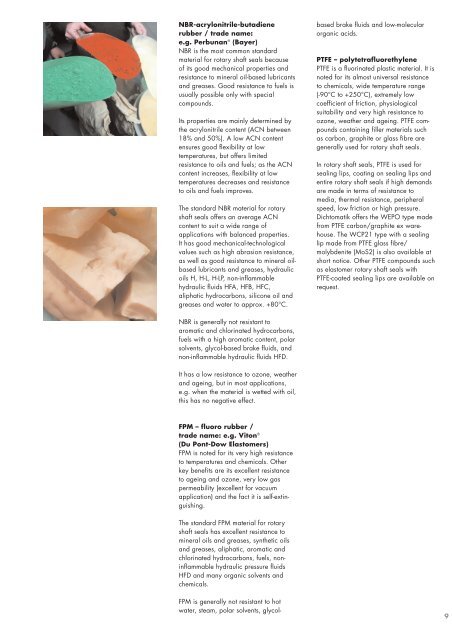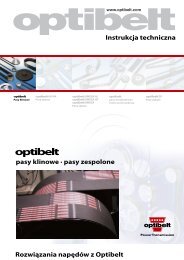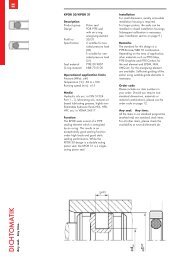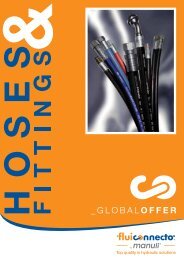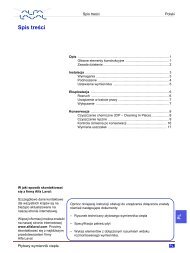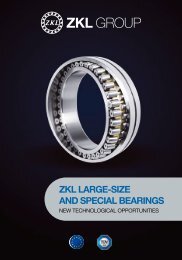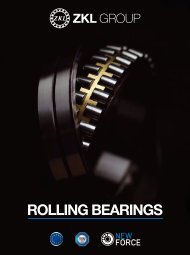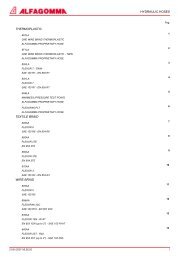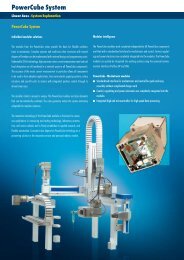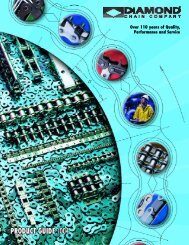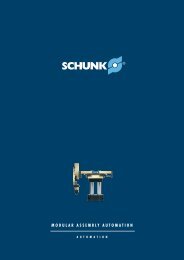DICHTOMATIK
DICHTOMATIK - Spinet
DICHTOMATIK - Spinet
- No tags were found...
Create successful ePaper yourself
Turn your PDF publications into a flip-book with our unique Google optimized e-Paper software.
NBR-acrylonitrile-butadiene<br />
rubber / trade name:<br />
e.g. Perbunan ® (Bayer)<br />
NBR is the most common standard<br />
material for rotary shaft seals because<br />
of its good mechanical properties and<br />
resistance to mineral oil-based lubricants<br />
and greases. Good resistance to fuels is<br />
usually possible only with special<br />
compounds.<br />
Its properties are mainly determined by<br />
the acrylonitrile content (ACN between<br />
18% and 50%). A low ACN content<br />
ensures good flexibility at low<br />
temperatures, but offers limited<br />
resistance to oils and fuels; as the ACN<br />
content increases, flexibility at low<br />
temperatures decreases and resistance<br />
to oils and fuels improves.<br />
The standard NBR material for rotary<br />
shaft seals offers an average ACN<br />
content to suit a wide range of<br />
applications with balanced properties.<br />
It has good mechanical-technological<br />
values such as high abrasion resistance,<br />
as well as good resistance to mineral oilbased<br />
lubricants and greases, hydraulic<br />
oils H, H-L, H-LP, non-inflammable<br />
hydraulic fluids HFA, HFB, HFC,<br />
aliphatic hydrocarbons, silicone oil and<br />
greases and water to approx. +80°C.<br />
FPM is generally not resistant to hot<br />
water, steam, polar solvents, glycolbased<br />
brake fluids and low-molecular<br />
organic acids.<br />
PTFE – polytetrafluorethylene<br />
PTFE is a fluorinated plastic material. It is<br />
noted for its almost universal resistance<br />
to chemicals, wide temperature range<br />
(-90°C to +250°C), extremely low<br />
coefficient of friction, physiological<br />
suitability and very high resistance to<br />
ozone, weather and ageing. PTFE compounds<br />
containing filler materials such<br />
as carbon, graphite or glass fibre are<br />
generally used for rotary shaft seals.<br />
In rotary shaft seals, PTFE is used for<br />
sealing lips, coating on sealing lips and<br />
entire rotary shaft seals if high demands<br />
are made in terms of resistance to<br />
media, thermal resistance, peripheral<br />
speed, low friction or high pressure.<br />
Dichtomatik offers the WEPO type made<br />
from PTFE carbon/graphite ex warehouse.<br />
The WCP21 type with a sealing<br />
lip made from PTFE glass fibre/<br />
molybdenite (MoS2) is also available at<br />
short notice. Other PTFE compounds such<br />
as elastomer rotary shaft seals with<br />
PTFE-coated sealing lips are available on<br />
request.<br />
NBR is generally not resistant to<br />
aromatic and chlorinated hydrocarbons,<br />
fuels with a high aromatic content, polar<br />
solvents, glycol-based brake fluids, and<br />
non-inflammable hydraulic fluids HFD.<br />
It has a low resistance to ozone, weather<br />
and ageing, but in most applications,<br />
e.g. when the material is wetted with oil,<br />
this has no negative effect.<br />
FPM – fluoro rubber /<br />
trade name: e.g. Viton ®<br />
(Du Pont-Dow Elastomers)<br />
FPM is noted for its very high resistance<br />
to temperatures and chemicals. Other<br />
key benefits are its excellent resistance<br />
to ageing and ozone, very low gas<br />
permeability (excellent for vacuum<br />
application) and the fact it is self-extinguishing.<br />
The standard FPM material for rotary<br />
shaft seals has excellent resistance to<br />
mineral oils and greases, synthetic oils<br />
and greases, aliphatic, aromatic and<br />
chlorinated hydrocarbons, fuels, noninflammable<br />
hydraulic pressure fluids<br />
HFD and many organic solvents and<br />
chemicals.<br />
9


